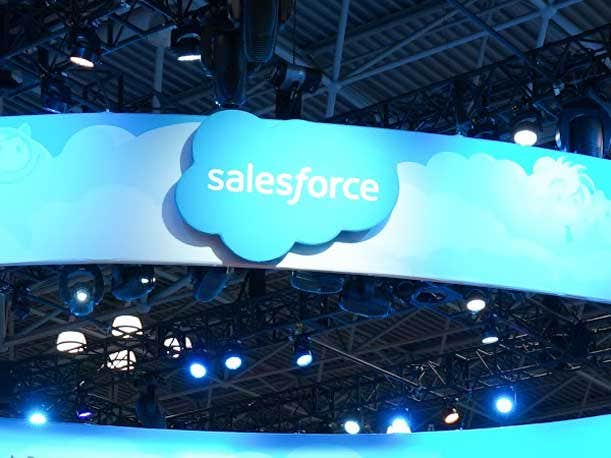Salesforce Q4 Earnings Preview: 5 Things To Know
Whether CEO and co-founder Marc Benioff will stay with the company, whether subsidiaries such as Tableau and Slack are up for sale and whether Salesforce expects additional layoffs and executive changes are all on the table.

Salesforce heads into a quarterly earnings report with company stakeholders looking for answers around what activist investors want from the enterprise applications vendor.
Whether CEO and co-founder Marc Benioff will stay with the company, whether subsidiaries such as Tableau and Slack are up for sale and whether Salesforce expects additional layoffs and executive changes are all on the table for the San Francisco-based vendor.
Multiple investment and financial services firms have published reports predicting mixed and muted results leading up to Wednesday’s earnings call for the fourth quarter of Salesforce’s fiscal year – a quarter that ended Jan. 31.
[RELATED: Salesforce Has Another Activist Investor: Report]
Salesforce Q4 Earnings Preview
Along with layoffs and moderated demand following a boom in digital tool purchasing at the height of the pandemic, Salesforce executives have had to work with a series of activist investors that have taken share in the vendor.
The investors appear to have played a hand in changes with Salesforce’s board of directors – with Mason Morfit, CEO and chief investment officer of ValueAct Capital, announced as an incoming director in January. But Salesforce might make clear other changes on Wednesday’s earnings call.
Here’s what you need to know.

Will Salesforce CEO Marc Benioff Stay?
Salesforce has attracted at least five activist investors: Third Point, Starboard Value, ValueAct Capital Partners, Elliott Investment Management and Jeff Ubben’s Inclusive Capital.
Notably, Third Point took a stake in Intel in 2020 before the chipmaker’s CEO Bob Swan stepped down and was replaced by VMware leader Pat Gelsinger.
A February report from financial services firm Macquarie said that activist investor Elliott – which made headlines for its role in Citrix going private and merging with data applications vendor Tibco – does not appear to seek the removal of co-founder and CEO Marc Benioff.
“Instead, succession planning with a solid co-CEO as a possibility would provide support as the company realigns,” according to Macquarie. “Certainly, there can be too many chefs in the kitchen, and we are likely past that point. It seems reasonable to conclude that cost-cutting and buybacks are the most obvious near-term solutions.”

Are Slack, Tableau, MuleSoft For Sale?
Some investors have questioned Salesforce’s 2021 $27.7 billion acquisition of Slack, according to a February report from investment firm Wedbush.
The firm predicts that Salesforce will “strategically look at possible spin-offs over the next 6-12 months depending on outside strategic interests as well as further cost cuts,” according to the report.
Salesforce’s other subsidiaries include Tableau and MuleSoft.
Not all firms agreed with Wedbush. A February report from Macquarie said divestitures “for the most part, do not make sense, in our view.”
And a February report from Morgan Stanley said that, “Though, we do not expect to hear of near-term changes to the management team or asset sales (i.e. a spinout of Slack or Tableau) on the Q4 call, these factors remain at the forefront of investors‘ minds given heavy involvement of the activist community.”
Based on partner checks conducted by the firm, Salesforce’s Marketing Cloud and Commerce Cloud were “two areas of better performance relative to initial expectations, while Sales Cloud and Tableau sound to have had less favorable quarters.”
Partners saw MuleSoft and Service Cloud having performances about in line with expectations, according to the report.
Salesforce’s focus on automating business processes could shield them to a degree from spending moving from front office to back office, according to Morgan Stanley.

Mixed Salesforce Q4 Expected
A February from investment firm Wedbush predicted “a roughly in-line January quarter with some puts and takes in the field that give some momentum into the next 12 to 18 months to turnaround this once golden growth story.”
The Wedbush analysts predict Salesforce will put pressure on under-performing assets.
Based on the analyst’s information, Salesforce had a mixed quarter with “continued weak spots/softening around lengthening sales cycles and isolated deal slippage seen in the field.”
“We have seen some improvement in large deal activity on core enterprise deals while the cross-selling pipeline deal flow has expanded this quarter,” according to the report.
Macquarie predicts “a muted 4Q like most of the major cloud providers, as it is a bull market purchase and partners noted pullbacks on large and expansive deals.”
“However, we think there is still new business growth and strength in core products to keep the company doing double-digit growth as margins expand,” according to the report.
A February report from Morgan Stanley said that, based on conversations with partners, Morgan Stanley expects a mixed quarter “with discussions of more modest year-end budget-flush relative to a normalized demand environment and FY24 (fiscal year 2024) pipeline coverage ratios slightly lower relative to recent years.”
Partner checks still reflect the longer sales cycles, higher level of approvals needed and greater net-new spending scrutiny that started last summer, according to Morgan Stanley.
“While our conversations did not indicate a material worsening in any of these macro-driven factors, partners did note modestly less budget-flush relative to more a normalized Q4, though January appears to have closed stronger relative to November & December,” according to Morgan Stanley. “Still, despite an uptick in January and customer budgets mostly flat-to-up marginally for the year-ahead, partners expect slightly lower growth in their Salesforce practices in CY23, with budget priorities favoring back-office IT initiatives and a general focus on budget optimization rather than new project spend.”
Weighing in on calendar year 2023 pipeline, partners saw “more of a back-half weighted pipeline and more moderate coverage ratios relative to recent years,” but “continue to highlight Salesforce as one of the most strategic vendors within customers‘ broader IT stack.”
Morgan Stanley expects remaining performance obligation of more than $23.6 billion, up about 7 percent year over year. Morgan Stanley expects the quarter’s current revenue performance obligation at about the expected 10 percent increase year over year, and next quarter’s current remaining performance obligation at more than 4.8 percent year over year, below Wall Street’s expected 6.8 percent year over year.
Morgan Stanley expects fiscal year 2024 revenue of about 6 percent to 8 percent year over year, in line with expectations. The firm expects fiscal year 2024 operating margins set at about 25 percent, according to the February report.
A February report on Salesforce competitor HubSpot by investment firm KeyBanc also noted “some early Salesforce checks indicating weakening growth rates into 2023 and some relative concern at this point in the cycle over front office.”

Competition From Microsoft
Salesforce faces a battle with Redmond, Wash.-based tech giant Microsoft over cloud and collaboration tools market share “over the next few years,” according to Wedbush.
In January, on Microsoft’s most recent quarterly earnings call, the vendor reported that collaboration application and Slack competitor Teams surpassed more than 280 million monthly active users during the quarter.
The results showed “durable momentum since the pandemic, and we continue to take share across every category—from collaboration to chat to meetings to calling,” Microsoft CEO Satya Nadella said on the earnings call.
Microsoft’s Dynamics suite of enterprise resource planning (ERP), CRM and business applications saw products and cloud services revenue grow by 20 percent year over year, the vendor reported. Dynamics 365 revenue growing 29 percent. The vendor predicted that Dynamics revenue growth in the current quarter should be in the low to mid teens.
A February report from Morgan Stanley said that, based on partner checks conducted by analysts, Salesforce is still No. 1 in its category.
But “partners do see Microsoft becoming more competitive in the mid-market, while SMB (small and midsize business) skews more favorably for lower-priced solutions with less cumbersome implementation requirements (i.e. Hubspot, Zendesk, Zoho).”
Partners told Morgan Stanley that Salesforce should explore a change to its pricing strategy to better incorporate “usage/interaction-based, volumetric pricing to help offset some of the near-term challenges to lower levels of customer seat expansions.”
“While we do not anticipate discussion of any such changes on the Q4 call, this is an area we will continue to monitor in our partner conversations going forward,” Morgan Stanley said.

More Employee Changes?
The Morgan Stanley report said that, based on partner conversations, more layoffs could be coming for Salesforce.
The majority of employee reductions “appear to have been largely concentrated to the customer success and channel partner relationship groups, though we did hear of some reductions in account executive headcount for those with a track record of underperformance,” according to Morgan Stanley.
“In our conversations, multiple partners also pointed to instances where account executives were retained to help close Q4 deals with an understanding they could see termination in the near-future, suggesting more headcount cuts could be on the horizon,” according to Morgan Stanley.
This year, Salesforce has seen multiple changes in its C-suite with the departure of President and Chief Strategy Officer Gavin Patterson, co-CEO Bret Taylor and Slack CEO Stewart Butterfield.
But the Morgan Stanley report said “we do not expect to hear of near-term changes to the management team … on the Q4 call,” although “these factors remain at the forefront of investors‘ minds given heavy involvement of the activist community.”